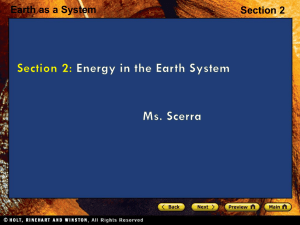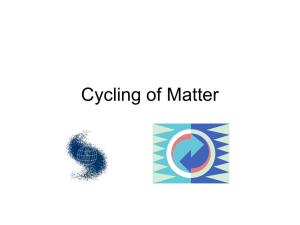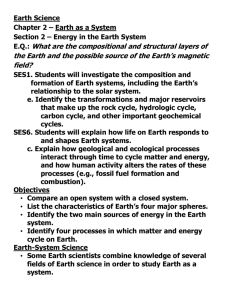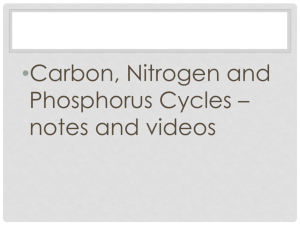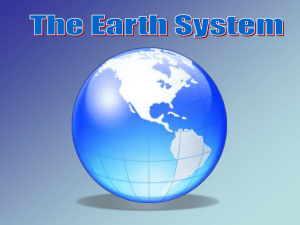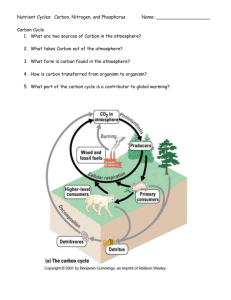Section 2 – Energy in the Earth System
advertisement
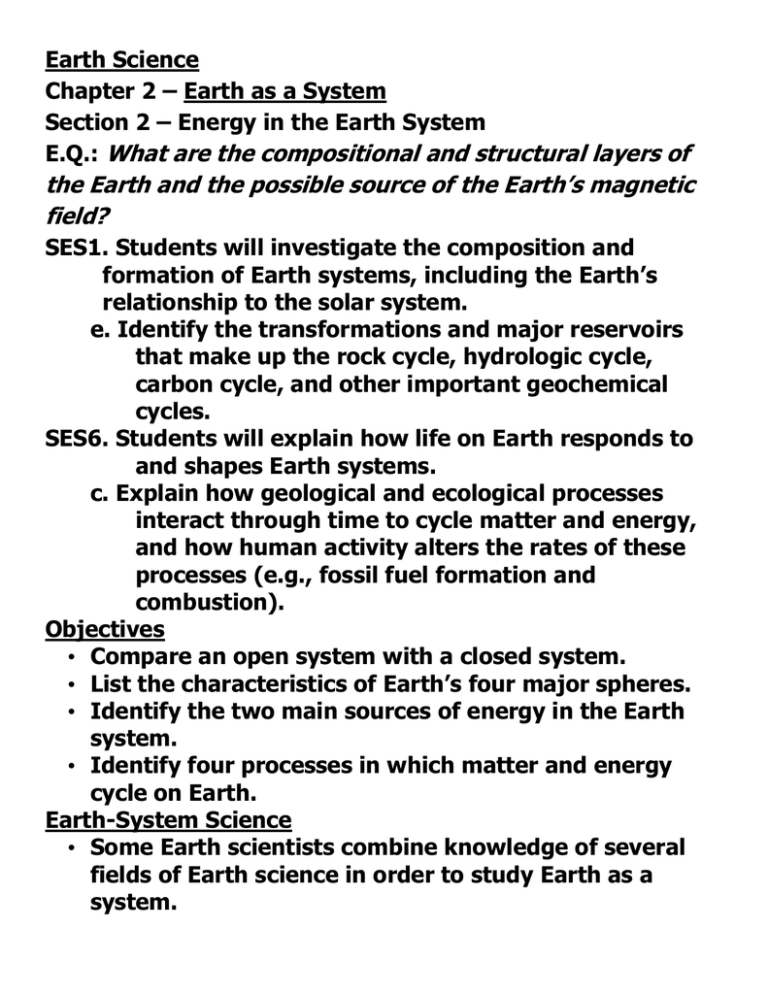
Earth Science Chapter 2 – Earth as a System Section 2 – Energy in the Earth System E.Q.: What are the compositional and structural layers of the Earth and the possible source of the Earth’s magnetic field? SES1. Students will investigate the composition and formation of Earth systems, including the Earth’s relationship to the solar system. e. Identify the transformations and major reservoirs that make up the rock cycle, hydrologic cycle, carbon cycle, and other important geochemical cycles. SES6. Students will explain how life on Earth responds to and shapes Earth systems. c. Explain how geological and ecological processes interact through time to cycle matter and energy, and how human activity alters the rates of these processes (e.g., fossil fuel formation and combustion). Objectives • Compare an open system with a closed system. • List the characteristics of Earth’s four major spheres. • Identify the two main sources of energy in the Earth system. • Identify four processes in which matter and energy cycle on Earth. Earth-System Science • Some Earth scientists combine knowledge of several fields of Earth science in order to study Earth as a system. • system a set of particles or interacting components considered to be a distinct physical entity for the purpose of study • All systems have boundaries, and many systems have matter and energy that flow though them. • Even though each system can be described separately, all systems are linked. A large and complex system, such as the Earth system, operates as a result of the combination of smaller, interrelated systems. • The operation of the Earth system is a result of interaction between the two most basic components of the universe: matter and energy. • Matter is anything that has mass and takes up space. • Energy is defined as the ability to do work. Energy can be transferred in a variety of forms, including heat, light, vibrations, or electromagnetic waves. • A system can be described by the way that matter and energy are transferred within the system or to and from other systems. Closed Systems • A closed system is a system in which energy, but not matter is exchanged with the surroundings. Open Systems • An open system is a system in which both energy and matter are exchanged with the surroundings. The figure below compares open and closed systems. The Earth System • Technically, all systems that make up the Earth system are open. • However, the Earth system is almost a closed system because matter exchange is limited. • Energy enters the system in the form of sunlight and is released into space as heat. • Only a small amount of dust and rock from space enters the system, and only a fraction of the hydrogen atoms in the atmosphere escape into space. Reading Check What types of matter and energy are exchanged between Earth and space? Dust and rock come to Earth from space, while hydrogen atoms from the atmosphere enter space from Earth. Solar energy enters Earth’s atmosphere and reradiated energy leaves Earth. Earth’s Four Spheres • Matter on Earth is in solid, liquid, and gaseous states. The Earth system is composed of four “spheres” that are storehouses of all of the planet’s matter. The Atmosphere • atmosphere a mixture of gases that surrounds a planet or moon • The atmosphere provides the air you breathe and shields Earth from the sun’s harmful radiation. The Hydrosphere • hydrosphere the portion of Earth that is water • Water covers 71% of Earth’s surface. • Water in the hydrosphere occur in the form of oceans, lakes, rivers, streams, glaciers and ice sheets, and groundwater. The Geosphere • geosphere the mostly solid, rocky part of Earth; extends from the center of the core to the surface of the crust • The geosphere includes all of the rock and soil on the surface of the continents and on the ocean floor. • The geosphere also includes the solid and molten interior of Earth. The Biosphere • biosphere the part of Earth where life exists; includes all of the living organisms on Earth • The biosphere is composed of all of the forms of life in the geosphere, in the hydrosphere, and in the atmosphere, as well as any organic matter that has not decomposed. • The biosphere extends from the deepest parts of the ocean to the atmosphere a few kilometers above Earth’s surface. Earth’s Energy Budget • The transfers of energy between Earth’s spheres can be thought of as parts of an energy budget. • The first law of thermodynamics states that energy is transferred between systems, but it cannot be created or destroyed. • The second law of thermodynamics states that when energy transfer occurs, matter becomes less organized with time. Thus, the universe’s energy is spread out more uniformly over time. • The constant exchange of matter and energy between Earth’s spheres happens through chemical reactions, radioactive decay, the radiation of energy ,and the growth and decay of organisms. The figure below shows Earth’s energy budget. Reading Check Define energy budget. An energy budget is the total distribution of energy to, from, and between Earth’s various spheres. Internal Sources of Energy • When Earth formed about 4.6 billion years ago, its interior was heated by radioactive decay and gravitational contraction. • The decay of radioactive atoms still generates enough heat to keep Earth’s interior hot. Earth’ interior also retains much of the energy from the planet’s formation. • By the process of convection, the heat in Earth’s interior is transferred through the layers of Earth and is released at Earth’s surface. External Energy Sources • Earth’s most important external energy source is the sun. • Solar radiation warms Earth’s atmosphere and surface. This heating causes the movement of air masses, which generates winds and ocean currents. Many chemical reactions on Earth also require solar energy. • Another important external source of energy is gravitational energy from the moon and sun. This energy helps generate tides that cause currents and drive the mixing of ocean water. Cycles in the Earth System • A cycle is a group of processes in which matter and energy repeatedly move through a series of reservoirs. • A reservoir is a place where matter or energy is stored. • Many elements on Earth cycle between reservoirs. These cycles rely on energy sources to drive them. • The length of time that energy or matter spends in a reservoir can vary from a few hours to several million years. The Nitrogen Cycle • In the nitrogen cycle, nitrogen moves from the air to soil, from soil to plants and animals, and back to air again. • Nitrogen is removed from air mainly by the action of nitrogen-fixing bacteria in the soil. • The nitrogen enters plants, which are eaten by animals. The nitrogen is returned to the soil by decay and by animal wastes. • Chemical processes that occur in the soil then release the nitrogen back into the air. The figure below illustrates the nitrogen cycle. Reading Check Identify two nitrogen reservoirs on Earth. Answers should include two of the following: the atmosphere, animals, soil, and plants. The Carbon Cycle • Carbon moves through all four spheres through the carbon cycle. • In the short-term carbon cycle, plants convert carbon dioxide, CO2, from the atmosphere into carbohydrates. When organisms’ bodies break down the carbohydrates and release some of the carbon back into the air as CO2 or through their organic wastes as CO2 or methane, CH4. • In the long-term carbon cycle, carbon is stored in the geosphere in a type of rock called a carbonate. The Phosphorus Cycle • During the phosphorus cycle, phosphorus moves through every sphere except the atmosphere. • Phosphorus enters soil and water when rock breaks down, when phosphorus in rock dissolves in water, or when organisms excrete phosphorus in their waste. • Plants absorb phosphorus through their roots and incorporate the phosphorus into their tissues. • Animals absorb the phosphorus when they eat the plants. When the animals die, the phosphorus returns to the environment through decomposition. The Water (Hydrology) Cycle • The movement of water from the atmosphere to Earth’s surface and back to the atmosphere is called the water cycle. • In the water cycle, water changes from liquid water to water vapor through the energy transfers involved in evaporation and transpiration. During these processes, water absorbs heat and changes into a gaseous state. • When the water loses energy, it condenses to form water droplets, such as those that form clouds and fall to Earth’s surface as precipitation. Humans and the Earth System • All natural cycles can be altered by human activities. • The carbon cycle is affected when humans use fossil fuels. • The nitrogen and phosphorus cycles are affected by agriculture. • Humans must be careful to moderate their influences on natural systems.
